 W
WThe rufous-capped babbler is a babbler species in the family Timaliidae. It occurs from the Eastern Himalayas to northern Thailand, Laos, eastern China to Vietnam and Taiwan. It inhabits foremost temperate forest and is listed as Least Concern on the IUCN Red List.
 W
WThe spot-necked babbler is a species of bird in the family Timaliidae.
 W
WThe Chinese barbet is a bird in the family Megalaimidae. The species was first described by Robert Swinhoe in 1870. It is endemic to southern China.
 W
WThe black baza is a small sized bird of prey found in the forests of the Northeast India, the eastern Himalayas, China and Southeast Asia. Many populations are migratory. The races in the Indian region are migratory, wintering in the south of the Peninsula and Sri Lanka. The black bazas have short, stout legs and feet with strong talons. A prominent crest is a feature of the bazas. They are found in dense forest often in small groups. They are also known to spend a lot of time perching on bare branches of tall trees rising above the forest canopy.
 W
WThe blue-bearded bee-eater is a species of bee-eater found in much of the Indian subcontinent and parts of Southeast Asia. This bee-eater is found in forest clearings. It is found mainly in the Malayan region but extends west into peninsular India. The blue feathers of its throat are elongated and often fluffed giving it its name. They have a loud call but are not as gregarious or active as the smaller bee-eaters, and their square ended tail lacks the typical "wires" made up of the shafts of the longer central tail feathers in many species.
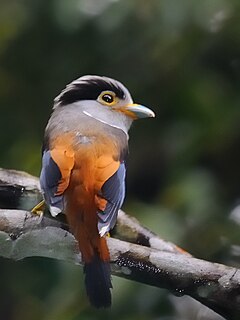 W
WThe silver-breasted broadbill is a species of bird in the broadbill family, Eurylaimidae. It is monotypic within the genus Serilophus. There are ten currently recognised subspecies, one of which, rubropygius, was formerly treated as a separate species.
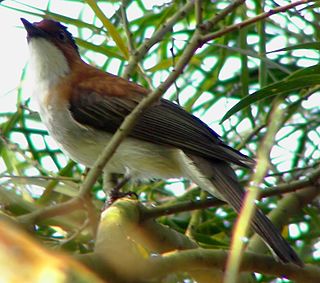 W
WThe chestnut bulbul or chestnut-backed bulbul is a songbird in the bulbul family, Pycnonotidae. The species was first described by Robert Swinhoe in 1870. It is found in southern China and northern Vietnam. Its natural habitat is subtropical or tropical moist lowland forests.
 W
WThe puff-throated bulbul is a songbird in the bulbul family, Pycnonotidae. The species was first described by Robert Swinhoe in 1870. It is found in Southeast Asia. Its natural habitat is subtropical or tropical moist lowland forests.
 W
WThe slaty-legged crake or banded crake is a waterbird in the rail and crake family, Rallidae.
 W
WThe Asian emerald cuckoo is a species of cuckoo in the family Cuculidae. It is found in Bangladesh, Bhutan, Cambodia, China, India, Indonesia, Laos, Malaysia, Myanmar, Nepal, Sri Lanka, Thailand, and Vietnam. Its natural habitats are subtropical or tropical moist lowland forests and subtropical or tropical moist montane forest.
 W
WThe fork-tailed drongo-cuckoo is a species of cuckoo that resembles a black drongo. It is found resident mainly in peninsular India in hill forests although some specimens are known from the Himalayan foothills. It can be easily distinguished by its straight beak and the white barred vent. It has a deeply forked tail often having a white spot on the back of the head. The song has been described as a series of 5 or 6 whistling "pip-pip-pip-pip-pip-" notes rising in pitch with each "pip".
 W
WThe bronzed drongo is a small Indomalayan bird belonging to the drongo group. They are resident in the forests of the Indian Subcontinent and Southeast Asia. They capture insects flying in the shade of the forest canopy by making aerial sallies from their perches. They are very similar to the other drongos of the region but are somewhat smaller and compact with differences in the fork depth and the patterns of gloss on their feathers.
 W
WThe crow-billed drongo is a species of bird in the family Dicruridae. It is native to moist tropical forests of southeastern Asia where its range extends from India to the Philippines and Indonesia. It is a completely black bird with a shallowly forked tail and is similar in appearance to the black drongo. It breeds between April and June, the cup-shaped nest being built in the fork of a branch by both birds, the female afterwards incubating the eggs. It is a common bird and the IUCN has listed it as "least concern".
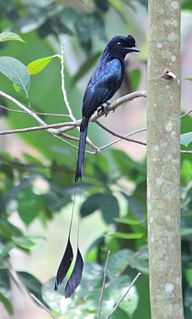 W
WThe greater racket-tailed drongo is a medium-sized Asian bird which is distinctive in having elongated outer tail feathers with webbing restricted to the tips. They are placed along with other drongos in the family Dicruridae. They are conspicuous in the forest habitats often perching in the open and by attracting attention with a wide range of loud calls that include perfect imitations of many other birds. One hypothesis suggested is that these vocal imitations may help in the formation of mixed-species foraging flocks, a feature seen in forest bird communities where many insect feeders forage together. These drongos will sometimes steal insect prey caught or disturbed by other foragers in the flock and another idea is that vocal mimicry helps them in diverting the attention of smaller birds to aid their piracy. They are diurnal but are active well before dawn and late at dusk. Owing to their widespread distribution and distinctive regional variation, they have become iconic examples of speciation by isolation and genetic drift.
 W
WThe fire-breasted flowerpecker is a species of bird in the family Dicaeidae found in the Indian Subcontinent and Southeast Asia. Like other flowerpeckers, this tiny bird feeds on fruits and plays an important role in the dispersal of fruiting plants. Unlike many other species in the genus, this species has marked sexual dimorphism with the male having contrasting upper and lower parts with a distinctive bright orange breast patch. The female is dull coloured.
 W
WThe Hainan blue flycatcher is a bird in the family Muscicapidae. The species was first described by William Robert Ogilvie-Grant in 1900. It is found in Cambodia, China, Hong Kong, Laos, Myanmar, Thailand, and Vietnam. Its natural habitat is subtropical or tropical moist lowland forests.
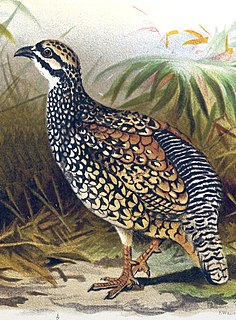 W
WThe Chinese francolin or Burmeese francolin is a species of game bird in the family Phasianidae.
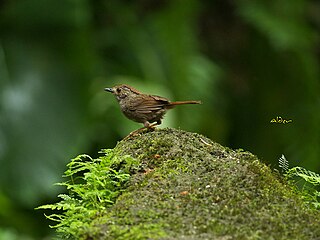 W
WThe dusky fulvetta is a species of bird in the family Pellorneidae. It is found in China and Taiwan. Its natural habitats are temperate forest and subtropical or tropical moist lowland forest.
 W
WThe grey-cheeked fulvetta is a bird in the family Alcippeidae. The species was first described by Robert Swinhoe in 1863.
 W
WThe cotton pygmy goose or cotton teal is a small perching duck which breeds in Asia, Southeast Asia extending south and east to Queensland where they are sometimes called white-quilled pygmy goose. They are among the smallest waterfowl in the world and are found in small to large waterbodies with good aquatic vegetation. They are usually seen in pairs or larger groups of pairs, roosting and nesting on trees near water. They are strong fliers and are known to disperse widely, especially in winter. Their breeding season coincides with the rains.
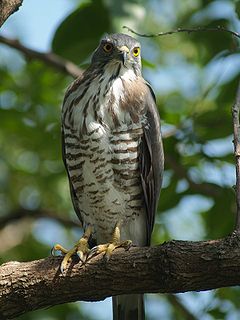 W
WThe crested goshawk is a bird of prey from tropical Asia. It is related to other diurnal raptors such as eagles, buzzards and harriers, and thus placed in the family Accipitridae.
 W
WHodgson's hawk-cuckoo, also known as the whistling hawk-cuckoo is a species of cuckoo found in north-eastern India, Myanmar, southern China and southeast Asia.
 W
WThe white-eared night heron is a species of heron in the family Ardeidae. It is found in southern China and northern Vietnam. It is threatened by habitat loss and habitat fragmentation.
 W
WThe black-capped kingfisher is a tree kingfisher which is widely distributed in tropical Asia from India east to China, Korea and Southeast Asia. This most northerly of the tree kingfishers is resident over much of its range, but northern populations are migratory, wintering south of their range in Sri Lanka, Thailand, Borneo and Java. It is distinctive in having a black cap that contrasts with the whitish throat, purple-blue wings and the coral red bill. The species is mainly found in coastal and mangrove habitats but can sometimes be found far inland.
 W
WBlyth's kingfisher is the largest kingfisher in the genus Alcedo. Named for Edward Blyth, the species has also been known as Alcedo grandis and as the great blue kingfisher. Between 22 and 23 centimetres long, the kingfisher has deep rufous underparts with a blackish blue breast patch, and brilliant cobalt blue or azure upperparts, tinged with purple. The wings are a dark blackish green, with blue speckles and tips to some of the feathers. The bill of the male is entirely black, while the female has a dark red lower mandible. The species is distinguished from the similar blue-eared kingfisher and common kingfisher by its greater size, heavy black bill, and dark lores.
 W
WThe crested kingfisher is a very large kingfisher that is native to parts of southern Asia, stretching eastwards from the Indian Subcontinent towards Japan. It forms a species complex with the other three Megaceryle species.
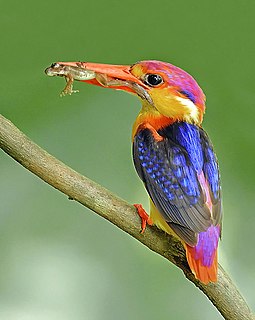 W
WThe oriental dwarf kingfisher, also known as the black-backed kingfisher or three-toed kingfisher, is a pocket-sized bird in the family Alcedinidae. This tropical kingfisher is a partial migrant that is endemic across much of the Indian Subcontinent and Southeast Asia. It resides in lowland forests, typically near streams or ponds, where it feeds upon insects, spiders, worms, crabs, fish, frogs, and lizards. This small bird is easily distinguishable from other birds in its range due to its red bill, yellow-orange underparts, lilac-rufous upperparts, and blue-black back.
 W
WThe white-throated kingfisher also known as the white-breasted kingfisher is a tree kingfisher, widely distributed in Asia from the Sinai east through the Indian subcontinent to the Philippines. This kingfisher is a resident over much of its range, although some populations may make short distance movements. It can often be found well away from water where it feeds on a wide range of prey that includes small reptiles, amphibians, crabs, small rodents and even birds. During the breeding season they call loudly in the mornings from prominent perches including the tops of buildings in urban areas or on wires.
 W
WThe Indochinese green magpie or yellow-breasted magpie is a passerine bird of the crow family, Corvidae. It is native to mainland southeast Asia (Indochina) and adjacent China.
 W
WThe common hill myna, sometimes spelled "mynah" and formerly simply known as the hill myna or myna bird, is the myna most commonly seen in aviculture, where it is often simply referred to by the latter two names. It is a member of the starling family (Sturnidae), resident in hill regions of South Asia and Southeast Asia. The Sri Lanka hill myna, a former subspecies of G. religiosa, is now generally accepted as a separate species G. ptilogenys. The Enggano hill myna and Nias hill myna are also widely accepted as specifically distinct, and many authors favor treating the southern hill myna from the Nilgiris and elsewhere in the Western Ghats of India as a separate species.
 W
WThe silver-backed needletail is a species of swift in the family Apodidae. It is found in Southeast Asia, Sumatra, Java and Taiwan. It is a vagrant to Christmas Island. Its natural habitat is subtropical or tropical moist lowland forests.
 W
WThe Fujian niltava is a species of bird in the family Muscicapidae. It is found in Cambodia, China, Hong Kong, Laos, Thailand, and Vietnam. Its natural habitats are subtropical or tropical moist lowland forest and subtropical or tropical moist montane forest.
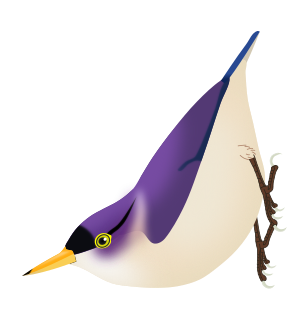 W
WThe yellow-billed nuthatch is a species of bird in the family Sittidae. It is found in Hainan, Laos, and Vietnam.
 W
WThe maroon oriole is a species of bird in the family Oriolidae. It is found in Southeast Asia.
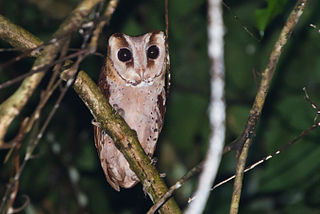 W
WThe oriental bay owl is a type of bay owl, usually classified with barn owls. It is completely nocturnal, and can be found throughout Southeast Asia and parts of India. It has several subspecies. It has a heart-shaped face with earlike extensions. The Congo bay owl was formerly classified as a subspecies of Oriental bay owl due to insufficient knowledge, but it has turned out that it might not even belong to the same genus. The Sri Lanka bay owl was also considered a subspecies.
 W
WThe red-breasted parakeet is among the more widespread species of the genus and is the species which has the most geographical variations. It is easily identified by the large red patch on its breast. An alternative name is the moustached parakeet depending on subspecies. Most of the subspecies are confined to minuscule islands or a cluster of islands in Indonesia. One subspecies occurs in the Andaman islands, and one subspecies occurs in continental Southeast Asia and partly extending to northeastern parts of South Asia along the foothills of the Himalayas. Some of the island races may be threatened by the wild bird trade. The nominate race, which occurs in Java, is close to extinction.
 W
WThe Hainan partridge is a species of bird in the family Phasianidae. It is endemic to Hainan Island, China. Its natural habitats are primary evergreen forests. It is threatened by habitat loss and has been assessed as a vulnerable species.
 W
WThe silver pheasant is a species of pheasant found in forests, mainly in mountains, of mainland Southeast Asia, and eastern and southern China, with introduced populations in Hawaii and various locations in the US mainland. The male is black and white, while the female is mainly brown. Both sexes have a bare red face and red legs. It is common in aviculture, and overall also remains common in the wild, but some of its subspecies are rare and threatened.
 W
WThe mountain imperial pigeon, also known as the maroon-backed imperial pigeon or Hodgson's imperial pigeon, is a species of bird in the pigeon and dove family with a wide range in south-eastern Asia.
 W
WThe blue-rumped pitta is a species of bird in the family Pittidae. It is found in Cambodia, China, Laos, Thailand, and Vietnam. Its natural habitats are subtropical or tropical moist lowland forest and subtropical or tropical moist montane forest.
 W
WThe white-tailed robin is an Old World flycatcher in the family Muscicapidae. It ranges across the northern regions of the Indian subcontinent and adjacent areas of Southeast Asia. It is found in Bangladesh, Bhutan, Cambodia, India, Laos, Malaysia, Myanmar, Nepal, Taiwan, Thailand, and Vietnam. Its natural habitats are subtropical or tropical moist lowland forest and subtropical or tropical moist montane forest.
 W
WThe clicking shrike-babbler is a species of bird in the family Vireonidae. It is found from Assam, India, eastern Myanmar to southern China, and southern Vietnam. Its natural habitats are subtropical or tropical moist lowland forests and subtropical or tropical moist montane forests. It used to be considered a subspecies of the chestnut-fronted shrike-babbler.
 W
WThe red-billed starling is a species of starling in the family Sturnidae. It is found in south and southeastern China.
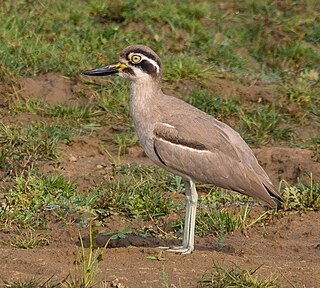 W
WThe great stone-curlew or great thick-knee is a large wader which is a resident breeder in tropical southern Asia from India, Pakistan, Sri Lanka, Bangladesh into South-east Asia.
 W
WThe orange-headed thrush is a bird in the thrush family.
 W
WThe sultan tit is a large songbird with a yellow crest, dark bill, black upperparts plumage and yellow underparts. The sexes are similar. The female has greenish black upperparts and yellowish throat. The young bird is duller than the adult and has a shorter crest. It is the only member of the monotypic genus Melanochlora, which is fairly distinct from the Parus tits with the nearest relative being the monotypic Sylviparus.
 W
WThe grey treepie, also known as the Himalayan treepie, is an Asian treepie, a medium-sized and long-tailed member of the crow family. The species was first described by Robert Swinhoe in 1863. They are widely distributed along the foothills of the Himalayas in the Indian Subcontinent and extending into Indochina, southern mainland China and Taiwan. The populations vary in plumage and several are named as subspecies.
 W
WThe ratchet-tailed treepie is a species of bird in the crow and jay family Corvidae. The species is also known as the notch-tailed treepie. It is monotypic within the genus Temnurus.
 W
WThe eyebrowed wren-babbler is a species of bird in the family Pellorneidae. It is found in Bhutan, China, India, Indonesia, Laos, Malaysia, Myanmar, Thailand, and Vietnam. Its natural habitats are subtropical or tropical moist lowland forest and subtropical or tropical moist montane forest.
 W
WThe greater yellownape is a species of bird in the woodpecker family Picidae.